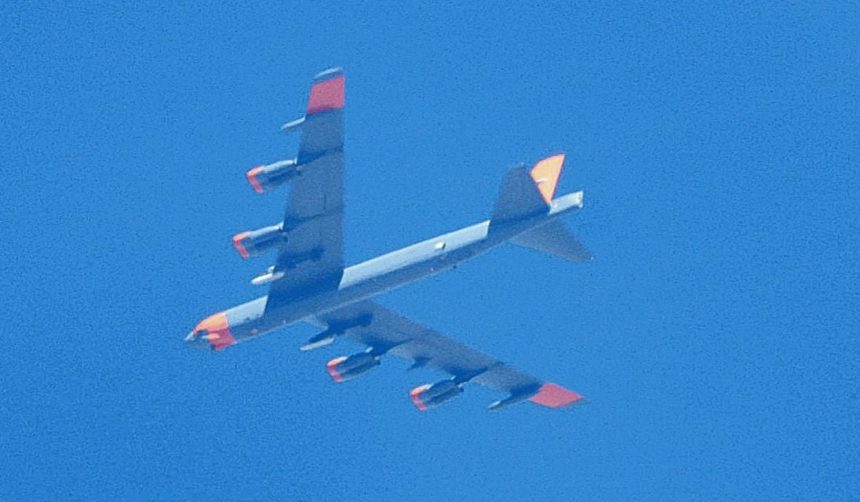The B-52, sporting the orange throwback paint scheme, has been spotted flying over Texas with two loads under the wing hardpoints, one of which clearly looks like an AGM-183 ARRW missile.
A U.S. Air Force B-52H Stratofortress bomber was spotted flying over Amarillo, Texas, on Mar. 5, 2025, while carrying two loads under its wings, with one apparently being the hypersonic AGM-183 Air-Launched Rapid Response Weapon (ARRW). Notably, the B-52 is the airframe 61-0028 which has recently received an amazing retro orange color scheme.
The photos that you can see in this article were sent to us by author, investigative journalist and photographer Steve Douglass. Our readers might remember that on March 10, 2014, in Amarillo, Steve Douglass and Dean Muskett took the famous photographs of three mysterious planes flying at a very high altitude over Texas. To date, we still don’t know what those aircraft were.
LOBO49 out of Barksdale AFB went to the UTTR (Utah Test and Training Range) maybe launched or dropped something and then RTB? 🤔
Audio via @liveatc https://t.co/mTMvsV8mt1 pic.twitter.com/I3vhjurRGr
— Thenewarea51 (@thenewarea51) March 5, 2025
The B-52 was also trackable through Multilateration (MLAT) of its Mode-S transponder signals, and thus visible on flight tracking websites like adsbexchange.com. The aircraft flew with the callsign LOBO49 from Barksdale Air Force Base, Louisiana, to the Utah Test and Training Range and back, as confirmed by a short radio message that was recorded via liveatc.net.
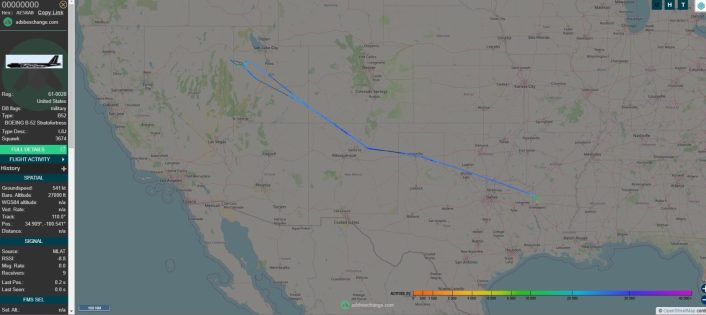
As the aircraft was flying at an altitude of 27,000 ft when it passed over Amarillo, the photos are not clear enough to confirm with 100% accuracy the presence of the AGM-183 ARRW under the B-52’s right wing. However, the size and the shape of the object in the photo match the ones of the hypersonic weapon. Someone suggested it could also be an AGM-158 LRSAM.
Under the left wing, another load is visible, although the different shape and size imply it has a different nature. Among the possible options are a ballast or a pod, with the latter possibly being the AgilePod-26 tested as part of the AgilePod TENTaCLE (Tactical Edge Network Targeting in a Contested Long-Range Environment) program to provide the bomber with advanced communications capabilities.
The combination of the two capabilities would be very interesting, as the ARRW, for instance, was being developed as a lethal, long-range strike capability to go after high-end capabilities of a potential adversary and the AgilePod-26 is intended to integrate advanced communications capabilities for the B-52 across all domains and enhance data transfer, weapon employment.
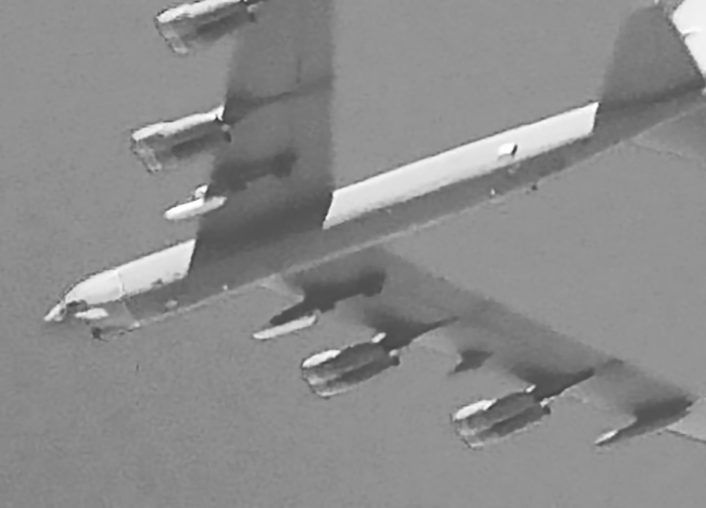
The AGM-183 ARRW
The AGM-183A ARRW is based on hypersonic glide vehicle technology derived from the Air Force and Defense Advanced Research Projects Agency (DARPA) Science and Technology (S&T) Demonstration known as Tactical Boost Glide (TBG). A fragmenting glide vehicle is launched from a conventional rocket, or more precisely a Solid-Rocket Motor (SRM) booster, to the upper atmosphere and, once it reaches hypersonic speeds, it separates from the rocket and glides to its target at speeds up to Mach 15. At these speeds, there is no need for a conventional explosive warhead as the kinetic energy alone delivered during impact would be enough to destroy most targets.
The Air Force also defined the ARRW as an “operational hypersonic air-launched weapon enabling the U.S. to hold fixed, high value, time-sensitive targets at risk in contested environments from standoff distances.” The missile would have provided a survivable, lethal, long-range strike capability to go after high-end capabilities of a potential adversary, such as deep-inland strike against targets of strategic importance and coastal strike against high-end systems. Initially, the expected introduction in service of the AGM-183 was planned for 2022.
In 2023, the Air Force said it does not currently intend to pursue follow-on procurement of ARRW once the prototyping program concludes, adding that there is inherent benefit to completing the all-up round test flights to garner the learning and test data that will help inform future hypersonic programs. The decision apparently was influenced by the latest test flight of the missile at that time, which ended with another failure. The FY 2025 Budget Request also did not include ARRW.
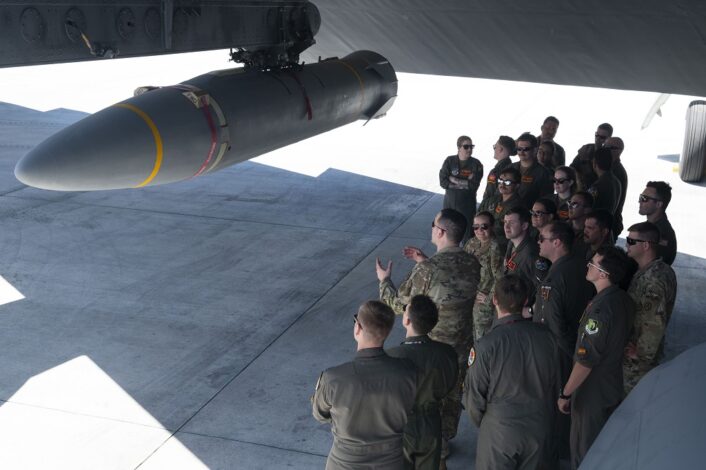
Although the Air Force decided in April 2023 to not pursue the procurement of the weapon, the Director, Operational Test & Evaluation report mentioned in 2024 that the ARRW program has shown preliminary indications that it could become an operationally lethal weapon, however the lack of terminal characterization data to date, due to technical failure of the test range sensor systems in the December 2022 test and the shroud not ejecting in March 2023, does not yet allow for a full assessment. Preliminary info released from the August 2023 test’s data analysis say it achieved nominal conditions.
The report continues saying that, given the limited number of planned test events, there is a risk that the test program will not be able to demonstrate the ARRW lethal effects against the required tactical and strategic targets. The survivability assessment estimated the probability that a single ARRW will complete its mission, given the capabilities of various early warning radars, surface-to-air missile systems, and anti-aircraft artillery batteries to detect and engage ARRW in various one-on-one scenarios, indicating that it will meet its survivability requirements.
The test conducted from Guam in 2024, which saw the launch of a live AGM-183 at the Reagan Test Site in the Pacific, was considered to be the last test of the hypersonic weapon. The test was significative as it represented the first time a U.S. hypersonic weapon was seen this close to China, and was supposed to replicate an operational mission where the bomber flies for 4,000 km before launching the hypersonic weapon.
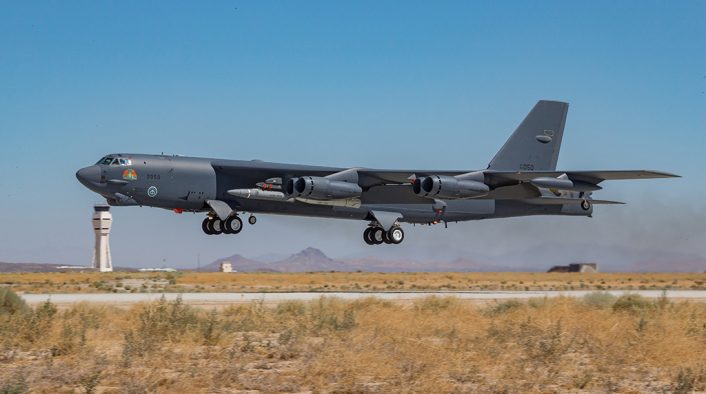
The AgilePod-26
The B-52 Stratofortress is involved in a massive upgrade program that is going to keep it at the forefront of the U.S. strategic bomber fleet through at least 2050. Among all the other things, the B-52J (as the re-engined Stratofortress will be designated), will also be equipped with advanced communication systems made available by the new AgilePod.
The AgilePod is a multi-function pod that can integrate advanced communications capabilities for the B-52 across all domains and enhance data transfer, weapon employment, and provide rapid solutions to emerging threats. The AgilePod TENTaCLE (Tactical Edge Network Targeting in a Contested Long-Range Environment) program is meant to quickly provide these needs to U.S. bombers without the years-long timelines required for a permanent modification to the aircraft.
The AgilePod-26 used for the B-52 program is a standards-based multi-mission pod designed by Jacobs company to carry Intelligence, Surveillance, and Reconnaissance (ISR) and Over The Horizon (OTH) communications payloads. Among the systems embedded in the pod there could be autonomy, machine learning, long range persistent surveillance or airborne satellite communications protocols, integrated via the modular and open-architecture design.
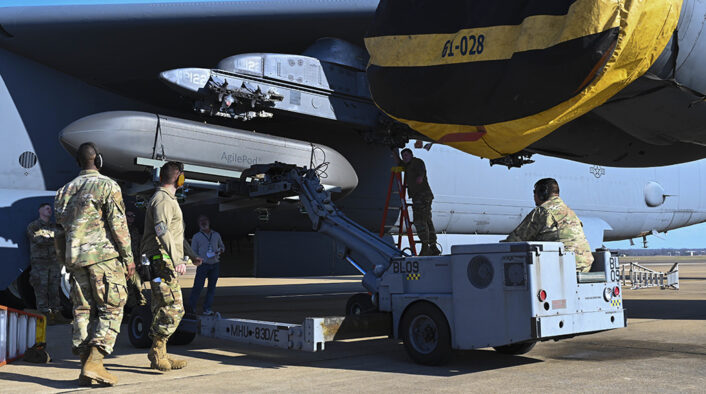
The B-52’s retro livery
The B-52H 61-0028 “Wolfpack” received in 2024 an amazing retro color scheme as a heritage back to the early days of the NASA B-52 testing campaigns. Specifically, the livery is similar to the famous NB-52B 52-0008 and closely resembles the NB-52A 52-0003.
The bomber had forward fuselage, wings near the wingtips, engine nacelles, and vertical stabilizer painted in dayglo orange, contrasting the typical overall dark gray paint of the Stratofortress aircraft. Upon return to Barksdale AFB, Louisiana, the B-52 received the “OT” and “49 TES” tail markings, black arrow point on the tail, and “U.S. Air Force” marking on the fuselage. This B-52 is, in fact, part of the 49th Test and Evaluation Squadron, which leads operational testing for the bombers.
The NB-52A and NB-52B Stratofortresses, to which this livery is inspired, were selected to serve as the launch platforms for the X-15 hypersonic research project in the 1950s. While the NB-52A 52-0003 was retired in 1969, the NB-52B 52-0008 continuing in this role until its final mission in November 2004, and contributed to multiple projects, such as the Space Shuttle program.
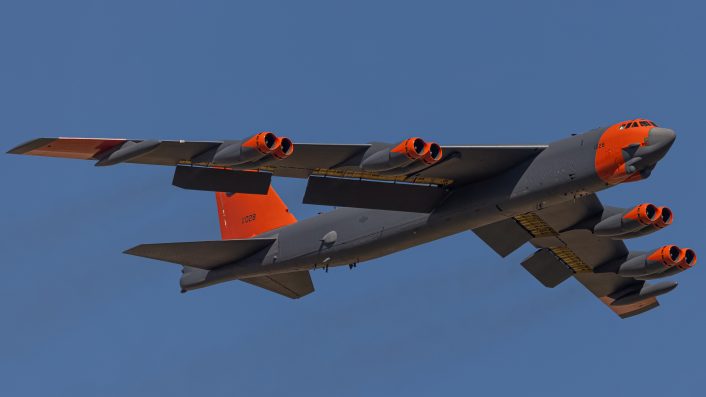
H/T Steve Douglass for the heads-up and images

